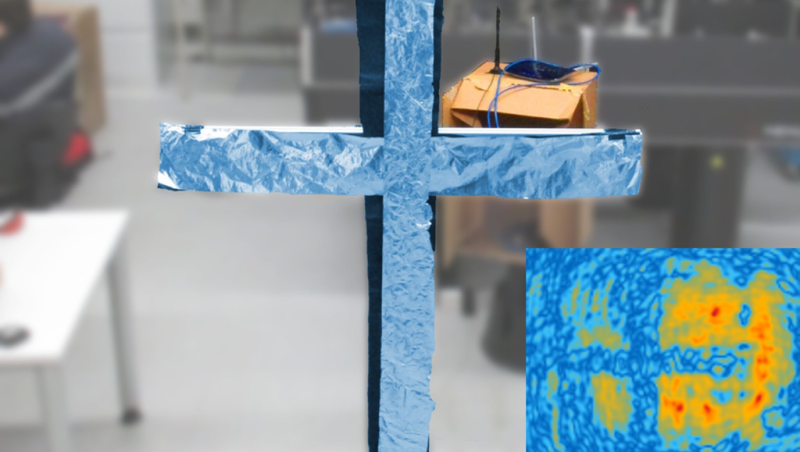 By Heather Hamilton, contributing writer
By Heather Hamilton, contributing writer
Researchers have found that modified Wi-Fi routers can emit radio signals that act as a radar and provide images of the environment in which the transmitter sits. Borrowing from holography, two German researchers found that Wi-Fi imaging could allow them to see through walls, providing images at 10 times per second, according to research published in Physical Review Letters.
Philipp Holl, an undergraduate student who worked with Dr. Friedemann Reinhard of the Technical University of Munich to develop the method, says that it isn’t exactly new. “The past two years have seen an explosion of methods for passive Wi-Fi imaging,” he remarked in an APS Physics article.
Despite growing interest in Wi-Fi imaging, inherent flaws in the system make it difficult to compete with radar systems that rely on specialized emitters to produce a wide range of frequencies. By contrast, Wi-Fi imaging uses commercial Wi-Fi sources, which are bound within narrow frequency bandwidths; this, together with the multiple reflections of nearby objects, makes it difficult to obtain an image from the Wi-Fi signal. To counter this setback, previous Wi-Fi imaging solutions used short pulses of ultra-wideband signals or highly directional Wi-Fi beams, which allow for images to be reconstructed based on the angle of signal arrival. This has measured human figures that are both stationary and moving and metallic devices in office environments.
Holl and Reinhard’s solution also relies on a standard router — which, again, utilizes a narrow bandwidth — but by using all of the Wi-Fi signal that reaches the detector, as opposed to throwing out some of the data as in previous methods, they were able to further improve the accuracy beyond existing solutions. “Because we record all available information — both direct illumination and reflections of the surroundings — our method should be the most accurate for localizing emitters and recognizing objects,” says Holl.
Essentially, the researchers treated the Wi-Fi wave front like a hologram, which is to say a two-dimensional image encoded like a three-dimensional image. By using mathematics developed for holographic imaging and for synthetic aperture radar, the pair amplified the contrast by subtracting an image of the emitter alone from its environment. APS Physics explains by comparing it to the subtraction of a bright source from an astronomical image to allow dimmer objects in the surrounding area to be seen.
Holl and Reinhard specifically used a commercial Wi-Fi transmitter utilizing a 5-GHz frequency, placing an antenna 2.3 m from the source and moving it across a plane. They placed a metal cross in the gap, which resulted in an image that clearly revealed the outline of the cross. “Wherever your laptop can get a Wi-Fi connection, we can record a hologram with a good signal-to-noise ratio,” says Holl.
The researchers demonstrated the approach on a larger scale by carrying out a computer simulation for a small building in which the upper floor contained a 3D grid of metal bars as representation of a structure in a storage building. Then, they reconstructed a series of 2D slices of the virtual building. Holl believes that a real experiment of this scale would need a large recording area. “It could be achievable with stationary arrays of antennas, installed, for instance, in the ceiling of a factory,” he says.
This method should be able to produce nearly ten 1,000×1,000-pixel snapshots per second of a dynamic environment with the signal strength of a typical Wi-Fi router. An article in Gizmodo also expresses concern because there’s only a set cone of light from the router inside of which images can be produced, which leaves anything outside of that blurry. And, while some question the speed of scanning the antenna, Holl believes that a number of antennas could solve the problem of speed. “Even using a single row of antennas, carried, for instance, by a drone or truck, could reduce the recording time to a few seconds,” he says.
The researchers also warn that “even encrypted communication transmits a three-dimensional picture of its surrounding to the outer world,” meaning that even our Wi-Fi routers are all set to reveal private information.
Sources: Gizmodo, APS Physics, Physical Review Letters
Image Source: APS Physics
Advertisement
Learn more about Electronic Products Magazine





